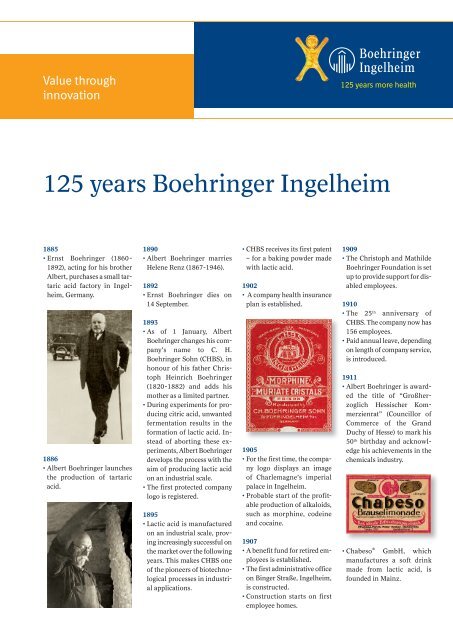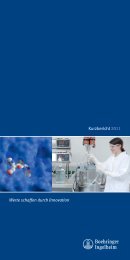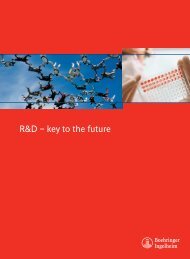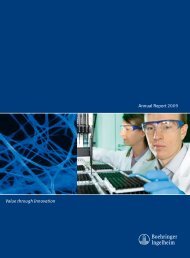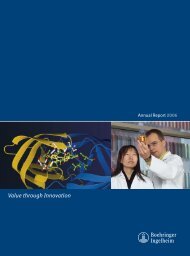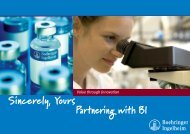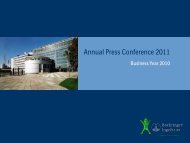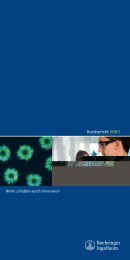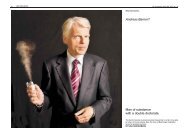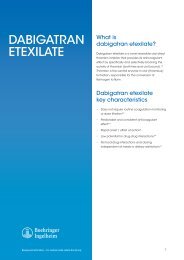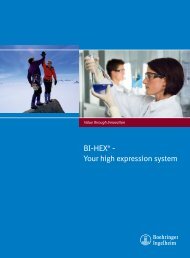Chronicle 125 Years Boehringer Ingelheim
Chronicle 125 Years Boehringer Ingelheim
Chronicle 125 Years Boehringer Ingelheim
You also want an ePaper? Increase the reach of your titles
YUMPU automatically turns print PDFs into web optimized ePapers that Google loves.
Value through<br />
innovation<br />
<strong>125</strong> years <strong>Boehringer</strong> <strong>Ingelheim</strong><br />
1885<br />
• Ernst <strong>Boehringer</strong> (1860-<br />
1892), acting for his brother<br />
Albert, purchases a small tartaric<br />
acid factory in <strong>Ingelheim</strong>,<br />
Germany.<br />
1886<br />
• Albert <strong>Boehringer</strong> launches<br />
the production of tartaric<br />
acid.<br />
1890<br />
• Albert <strong>Boehringer</strong> marries<br />
Helene Renz (1867-1946).<br />
1892<br />
• Ernst <strong>Boehringer</strong> dies on<br />
14 September.<br />
1893<br />
• As of 1 January, Albert<br />
<strong>Boehringer</strong> changes his company’s<br />
name to C. H.<br />
<strong>Boehringer</strong> Sohn (CHBS), in<br />
honour of his father Christoph<br />
Heinrich <strong>Boehringer</strong><br />
(1820-1882) and adds his<br />
mother as a limited partner.<br />
• During experiments for producing<br />
citric acid, unwanted<br />
fermentation results in the<br />
formation of lactic acid. Instead<br />
of aborting these experiments,<br />
Albert <strong>Boehringer</strong><br />
develops the process with the<br />
aim of producing lactic acid<br />
on an industrial scale.<br />
• The first protected company<br />
logo is registered.<br />
1895<br />
• Lactic acid is manufactured<br />
on an industrial scale, proving<br />
increasingly successful on<br />
the market over the following<br />
years. This makes CHBS one<br />
of the pioneers of biotechnological<br />
processes in industrial<br />
applications.<br />
• CHBS receives its first patent<br />
– for a baking powder made<br />
with lactic acid.<br />
1902<br />
• A company health insurance<br />
plan is established.<br />
1905<br />
• For the first time, the company<br />
logo displays an image<br />
of Charlemagne’s imperial<br />
palace in <strong>Ingelheim</strong>.<br />
• Probable start of the profitable<br />
production of alkaloids,<br />
such as morphine, codeine<br />
and cocaine.<br />
1907<br />
• A benefit fund for retired employees<br />
is established.<br />
• The first administrative office<br />
on Binger Straße, <strong>Ingelheim</strong>,<br />
is constructed.<br />
• Construction starts on first<br />
employee homes.<br />
nopq<br />
<strong>125</strong> years more health<br />
1909<br />
• The Christoph and Mathilde<br />
<strong>Boehringer</strong> Foundation is set<br />
up to provide support for disabled<br />
employees.<br />
1910<br />
• The 25 th anniversary of<br />
CHBS. The company now has<br />
156 employees.<br />
• Paid annual leave, depending<br />
on length of company service,<br />
is introduced.<br />
1911<br />
• Albert <strong>Boehringer</strong> is awarded<br />
the title of “Großherzoglich<br />
Hessischer Kommerzienrat”<br />
(Councillor of<br />
Commerce of the Grand<br />
Duchy of Hesse) to mark his<br />
50 th birthday and acknowledge<br />
his achievements in the<br />
chemicals industry.<br />
• Chabeso® GmbH, which<br />
manufactures a soft drink<br />
made from lactic acid, is<br />
founded in Mainz.
2<br />
1912<br />
• Laudanon®, an analgesic<br />
based on six opium alkaloids,<br />
is CHBS’s the first pharmaceutical<br />
speciality.<br />
• The works fire brigade is established.<br />
• A company pension fund is<br />
introduced for employees<br />
who have been with CHBS<br />
for 20 years or more.<br />
1913<br />
• Robert <strong>Boehringer</strong> (1884-<br />
1974), a nephew of Albert<br />
<strong>Boehringer</strong>, joins the company.<br />
1915<br />
• While Albert <strong>Boehringer</strong> is<br />
away at war until 1917, his<br />
nephew Robert <strong>Boehringer</strong><br />
takes over the management<br />
of CHBS.<br />
• The Albert and Helene<br />
<strong>Boehringer</strong> Foundation for<br />
the war-bereaved is founded.<br />
1917<br />
• The research department is set<br />
up and initially headed by<br />
the chemist Heinrich Wieland<br />
(1877-1957), one of Albert<br />
<strong>Boehringer</strong>’s cousins.<br />
• The company offers meals<br />
to employees for the first<br />
time.<br />
1918<br />
• World War I ends.<br />
1919<br />
• Albert <strong>Boehringer</strong>’s three<br />
children, Albert Jr. (1891-<br />
1960), Ilse Liebrecht (1894-<br />
1978) and Ernst (1896-1965),<br />
become partners of CHBS.<br />
• Albert <strong>Boehringer</strong> Jr. joins the<br />
company.<br />
1920<br />
• Julius Liebrecht (1891-1974),<br />
the founder’s son-in-law,<br />
joins the company.<br />
• The cardiovascular drug<br />
Cadechol® is launched.<br />
<strong>125</strong> years <strong>Boehringer</strong> <strong>Ingelheim</strong> C H R O N I C L E<br />
1921<br />
• Albert <strong>Boehringer</strong> receives an<br />
honorary doctorate from the<br />
University of Freiburg in<br />
Breisgau and becomes an<br />
honorary citizen of <strong>Ingelheim</strong><br />
to mark his 60 th birthday.<br />
• Heinrich Wieland and his<br />
brother, the pharmacologist<br />
Hermann Wieland (1885-<br />
1929), manage to isolate the<br />
pure alkaloid lobelin from<br />
the plant “Lobelia inflata”.<br />
This for its time innovative<br />
substance is launched under<br />
its scientific name Lobelin®.<br />
In 1936, it is synthetically<br />
manufactured on an industrial<br />
scale.<br />
1923<br />
• Albert <strong>Boehringer</strong> provides<br />
his own emergency funds to<br />
CHBS in response to hyper-inflation.<br />
• The company<br />
founder<br />
and his<br />
son Albert<br />
Jr. are<br />
banished<br />
from <strong>Ingelheim</strong><br />
by the<br />
French occupationauthorities<br />
and<br />
move to<br />
Hamburg<br />
where CHBS<br />
builds a branch in Hamburg-<br />
Moorfleet. From 1925, the<br />
basic elements of drugs, including<br />
caffeine, morphine<br />
and codeine, are produced at<br />
this plant.<br />
1926<br />
• Dr. Karl Thomä & Cie in<br />
Winnenden, near Stuttgart,<br />
begins morphine processing<br />
for the branch in Hamburg.<br />
The chemical company’s<br />
founders in 1874/75 included<br />
Alexander <strong>Boehringer</strong><br />
(1847-1897), a cousin of Albert<br />
<strong>Boehringer</strong>.<br />
1927<br />
• Professor Heinrich Wieland<br />
is awarded the Nobel Prize<br />
for chemistry for his investigation<br />
of the composition of<br />
bile acids and related compounds.<br />
• Ernst <strong>Boehringer</strong> joins the<br />
company after completing his<br />
dissertation on studies of alkaloid<br />
groups.<br />
1928<br />
• Albert <strong>Boehringer</strong> purchases<br />
the company Dr. Karl Thomä<br />
& Cie., including its share under<br />
the German Opium Convention<br />
and manufacturing<br />
methods and patents.<br />
1929<br />
• As of 1 January, CHBS becomes<br />
public limited company<br />
C. H. <strong>Boehringer</strong> Sohn AG.<br />
1930<br />
• Sympatol®, a derivative of<br />
adrenaline, is launched.<br />
• The baking and food department<br />
is established.<br />
1931<br />
• The company management is<br />
forced to return to <strong>Ingelheim</strong><br />
amid worsening global economic<br />
conditions. CHBS now<br />
employs 763 people.<br />
1932<br />
• The number of employees<br />
drops to 562 during the global<br />
economic crisis.<br />
1933<br />
• Work begins on the production<br />
of citric acid from calcium<br />
citrate for the foodstuffs,<br />
drinks and tobacco industry.<br />
1935<br />
• CHBS’s 50 th anniversary.<br />
The company now employs<br />
865 people.<br />
1936<br />
• The first company newspaper<br />
is published.<br />
• Large-scale synthesis is initiated<br />
for Lobelin®, launched as<br />
the respiratory stimulant Lobeton®<br />
(Lobelin <strong>Ingelheim</strong>).<br />
1937<br />
• As of 1 January, the public<br />
limited company CHBS becomes<br />
a limited partnership<br />
and its management is assumed<br />
by the personally<br />
liable shareholder Albert<br />
<strong>Boehringer</strong> Jr. and his brother<br />
Ernst, together with their<br />
brother-in-law Julius Liebrecht.
1939<br />
• The company founder, Albert<br />
<strong>Boehringer</strong>, dies at the age<br />
of 78 years on 11 March<br />
1939.<br />
• Production of citric acid<br />
through fermentation is begun.<br />
• CHBS now employs 1,200<br />
people.<br />
1941<br />
• The innovative broncholytic<br />
Aleudrin®/Aludrin® is<br />
launched. Aludrin®, the first<br />
asthma drug from CHBS, is<br />
introduced, paving the way<br />
for beta-blockers (the patent<br />
is confiscated by the allies after<br />
World War II).<br />
• CHBS now employs 1,500<br />
people.<br />
1942<br />
• A new plant is constructed<br />
in <strong>Ingelheim</strong> for the largescale<br />
production of synthetic<br />
caffeine and enters production<br />
on 15 November.<br />
1943<br />
• On 5 August, the German<br />
chemicals authorities issue a<br />
requirement that CHBS is to<br />
construct alternative plants<br />
for the manufacture of Sympatol®,<br />
Aludrin®, Adrianol®,<br />
Lobelin® and Papaverin®. The<br />
chosen location is Biberach<br />
an der Riss, Upper Swabia.<br />
1944<br />
• In the autumn, operations for<br />
tartaric, lactic and citric acid<br />
shut down due to a shortage<br />
of coal, bringing to an end<br />
production of tartaric acid,<br />
the oldest organic acid manufactured<br />
by CHBS.<br />
1945<br />
• On 16 March, CHBS closes its<br />
factory gates in <strong>Ingelheim</strong>.<br />
Four days later, the first<br />
American tanks reach <strong>Ingelheim</strong>.<br />
Occupation follows,<br />
first by American troops and<br />
then by the French. On 28<br />
May, it is announced that the<br />
factory is working again:<br />
The chimneys are back to<br />
work at <strong>Boehringer</strong>.<br />
1946<br />
• Helene <strong>Boehringer</strong>, wife of<br />
the company founder Albert<br />
<strong>Boehringer</strong>, dies on 16<br />
March.<br />
• The company Dr. Karl<br />
Thomae GmbH in Biberach<br />
an der Riss is re-established<br />
with 70 employees and the<br />
analgesic Thomapyrin® is<br />
launched.<br />
• CELA (Landwirtschaftliche<br />
Chemikalien GmbH) is<br />
founded, initially producing<br />
pesticides to protect against<br />
Colorado beetle infestation.<br />
• Haus-Chemie GmbH, Wiesbaden<br />
is established.<br />
1948<br />
• The first subsidiary outside<br />
Germany is established:<br />
Bender & Co. Ges mbH in Vienna<br />
(now <strong>Boehringer</strong> <strong>Ingelheim</strong><br />
RCV GmbH & Co. KG).<br />
• Olivin, a cosmetic products<br />
company, is set up.<br />
1949<br />
• The efforts of Robert<br />
<strong>Boehringer</strong> see the beginning<br />
of a long, successful partnership<br />
with the Swiss pharmaceutical<br />
company J. R. Geigy<br />
AG. Thomae takes over the<br />
production and sole distribution<br />
of Geigy’s pharmaceutical<br />
specialities in Germany.<br />
• The circulatory drug Effortil®<br />
is launched.<br />
1951<br />
• Buscopan®, an analgesic<br />
and spasmolytic agent, is<br />
launched.<br />
• Pesticides manufacture is<br />
initiated in Hamburg.<br />
• Finalgon®-Salbe, for percutaneous<br />
thermal stimulation<br />
therapy, is the first product<br />
launched by researchers at<br />
Thomae in Biberach.<br />
• The first issue of the company<br />
newspaper since World<br />
War II is published.<br />
1954<br />
• The manufacture of trichlorphenol<br />
is discontinued, after<br />
some employees at the Hamburg-Moorfleet<br />
site develop<br />
chloracne.<br />
1955<br />
• Walter Rudolf Mayer-List,<br />
responsible for company’s<br />
finances, becomes the first<br />
personally liable shareholder<br />
unrelated to the founding<br />
family.<br />
• The <strong>Ingelheim</strong>er Wohnungsgesellschaft<br />
mbH, housing<br />
organisation, is founded in<br />
which CHBS holds 75% of<br />
the shares (the town of <strong>Ingelheim</strong><br />
holds the remaining<br />
shares).<br />
• The company establishes its<br />
Animal Health division.<br />
1957<br />
• On 1 January, the “Geschwister<br />
<strong>Boehringer</strong> <strong>Ingelheim</strong><br />
Stiftung für Geisteswissenschaften”,<br />
a foundation<br />
for the humanities, begins<br />
work.<br />
• The production of trichlorphenol<br />
is resumed in Hamburg-Moorfleet<br />
after the procedure<br />
was improved and<br />
tested.<br />
1958<br />
• Anasco, Arznei- und Gesundheitspflegemittel<br />
GmbH<br />
is established in Wiesbaden.<br />
<strong>125</strong> years <strong>Boehringer</strong> <strong>Ingelheim</strong> C H R O N I C L E<br />
3
4<br />
1959<br />
• Ernst <strong>Boehringer</strong> founds the<br />
“International Days”, annual<br />
art exhibition in <strong>Ingelheim</strong>.<br />
• The cardiovascular drug<br />
Persantin®, developed by<br />
Thomae, is launched.<br />
• The Thomae subsidiary<br />
Basotherm dermatologische<br />
und pharmazeutische Gesellschaft<br />
mbH, Biberach is set<br />
up.<br />
1960<br />
• Albert <strong>Boehringer</strong> Jr. dies on<br />
11 February.<br />
• Silomat®, for the treatment of<br />
chesty coughs, is launched.<br />
<strong>125</strong> years <strong>Boehringer</strong> <strong>Ingelheim</strong> C H R O N I C L E<br />
1961<br />
• The asthma drug Alupent® is<br />
launched.<br />
1963<br />
• A works council, which<br />
serves as an advisory body<br />
from 1977 onwards, begins<br />
its work on 1 January. The<br />
first members are Hermann<br />
Richter, Harald Dyckerhoff<br />
and Theodor Wieland, son of<br />
Heinrich Wieland.<br />
1965<br />
• Ernst <strong>Boehringer</strong> dies on<br />
11 January.<br />
• Adumbran®, a tranquiliser,<br />
is launched.<br />
• The company now employs<br />
9,300 people.<br />
1966<br />
• Catapresan®, a high blood<br />
pressure medication, is<br />
launched.<br />
1967<br />
• Hubertus Liebrecht (1931-<br />
1991), and Wilhelm <strong>Boehringer</strong>,<br />
the grandsons of the<br />
company’s founder, join the<br />
Board of Managing Directors.<br />
Dr. Wilhelm<br />
<strong>Boehringer</strong><br />
Hubertus<br />
Liebrecht<br />
• In March, Chabeso® GmbH<br />
closes.<br />
1971<br />
• As of 1 January, Hubertus<br />
Liebrecht takes over from his<br />
father Julius as Chairman<br />
of the Board.<br />
• Bioscientia, Biochemische<br />
Dienstleistungsgesellschaft<br />
mbH, is established.<br />
1972<br />
• Celamerck GmbH & Co. KG<br />
is established by merging<br />
Cela <strong>Ingelheim</strong> and Merck’s<br />
pesticide business in Darmstadt.<br />
• Lactic acid production is discontinued.<br />
• The asthma drug Berotec® is<br />
launched.<br />
• Transfer of sale of the Geigy<br />
products to the newly established<br />
Ciba-Geigy AG.<br />
1973<br />
• <strong>Boehringer</strong> <strong>Ingelheim</strong> GmbH<br />
is founded as the German<br />
holding company for the<br />
group’s foreign subsidiaries.<br />
1974<br />
• Robert <strong>Boehringer</strong> dies on<br />
9 August.<br />
• Julius Liebrecht dies on<br />
13 September.<br />
• Anasco merges with Haus-<br />
Chemie to form Anasco<br />
GmbH, Wiesbaden.<br />
1975<br />
• Wilhelm <strong>Boehringer</strong> dies on<br />
12 January.<br />
• Atrovent®, a drug used in the<br />
treatment of chronic obstructive<br />
pulmonary disease<br />
(COPD), is launched.<br />
1977<br />
• Hubertus Liebrecht founds<br />
the “<strong>Boehringer</strong> <strong>Ingelheim</strong><br />
Foundation” to promote<br />
medical, biological, chemical<br />
and pharmaceutical research.<br />
• Since 1995, it has also sponsored<br />
the <strong>Boehringer</strong> <strong>Ingelheim</strong><br />
Prize, which is awarded<br />
by the medical faculty of<br />
the Johannes Gutenberg University<br />
in Mainz for outstanding<br />
medical research.
1978<br />
• The veterinary medicine department<br />
is established as a<br />
separate entity <strong>Boehringer</strong><br />
<strong>Ingelheim</strong> Vetmedica GmbH.<br />
1979<br />
• Mexitil®, for arrhythmia,<br />
and Mucosolvan® (Thomae)<br />
for bronchitis, are launched.<br />
1981<br />
• CHBS becomes the holding<br />
company for German companies<br />
and the newly founded<br />
<strong>Ingelheim</strong> International<br />
GmbH becomes the holding<br />
company for companies outside<br />
Germany.<br />
• <strong>Boehringer</strong> <strong>Ingelheim</strong> KG<br />
is established for the German<br />
business.<br />
• The group now employs<br />
14,822 people worldwide,<br />
8,750 of whom are in Germany.<br />
1982<br />
• Citric acid production is discontinued,<br />
marking the end<br />
of <strong>Boehringer</strong> <strong>Ingelheim</strong>’s<br />
work in organic acids, an area<br />
that played a key role in the<br />
company’s early economic<br />
success.<br />
1983<br />
• Erich von Baumbach, son-inlaw<br />
of Albert <strong>Boehringer</strong> Jr.,<br />
joins central management.<br />
• The “<strong>Boehringer</strong> <strong>Ingelheim</strong><br />
Fonds, Stiftung für medizinischeGrundlagenforschung”<br />
(BIF), a foundation<br />
that supports basic rsearch in<br />
medicine, is established.<br />
1984<br />
• On 18 June, production ceases<br />
in Hamburg-Moorfleet<br />
and the plant is closed. On 16<br />
November, Dekonta GmbH is<br />
set up to undertake the cleanup<br />
of the Hamburg site.<br />
1985<br />
• <strong>Boehringer</strong> <strong>Ingelheim</strong> celebrates<br />
its centennial with<br />
22,254 employees, 8,784 of<br />
whom are in Germany.<br />
• The Institute for Molecular<br />
Pathology (IMP) is established<br />
in Vienna as a joint<br />
venture with Genentech, Inc.<br />
(USA). Since 1993, the IMP<br />
has been solely owned by<br />
<strong>Boehringer</strong> <strong>Ingelheim</strong>.<br />
1986<br />
• The biotechnological centre<br />
in Biberach commences production.<br />
The 150 million<br />
deutsch-mark investment is<br />
Europe’s largest plant for the<br />
production of biopharmaceuticals<br />
from cell cultures.<br />
1987<br />
• Actilyse®, used in the treatment<br />
of acute heart attacks,<br />
and the first biotech product<br />
manufactured by Thomae/<br />
<strong>Boehringer</strong> <strong>Ingelheim</strong>, is officially<br />
approved.<br />
• Celamerck GmbH is sold.<br />
1989<br />
• <strong>Boehringer</strong> <strong>Ingelheim</strong> Zentrale<br />
GmbH changes its name<br />
to <strong>Boehringer</strong> <strong>Ingelheim</strong><br />
GmbH.<br />
• The central management<br />
becomes the Board of Managing<br />
Directors.<br />
1991<br />
• Hubertus Liebrecht dies on<br />
27 July.<br />
• <strong>Boehringer</strong> <strong>Ingelheim</strong> now<br />
employs 24,347 people<br />
worldwide.<br />
1992<br />
• Erich von Baumbach is appointed<br />
Chairman of the<br />
Shareholders’ Committee on<br />
1 January. At the same time,<br />
Heribert Johann is appointed<br />
spokesman for the Board of<br />
Managing Directors. Thus,<br />
for the first time in the company’s<br />
history, no members of<br />
the owning family are in<br />
charge of operational business<br />
at <strong>Boehringer</strong> <strong>Ingelheim</strong>.<br />
1993<br />
• The German pharmaceutical<br />
business with its two sites –<br />
<strong>Ingelheim</strong> and Biberach – is<br />
placed under common management.<br />
In future, research<br />
activities will be centred in<br />
Biberach, while production –<br />
though not biopharmaceutical<br />
production – will take<br />
place in <strong>Ingelheim</strong>.<br />
1994<br />
• The “Vision and Leadership“<br />
program initiated by the<br />
Shareholders’ Committee<br />
and the Board of Managing<br />
Directors, which sets the future<br />
direction for the worldwide<br />
Corporation, is presented<br />
and discussed. One year<br />
later, the first “Value through<br />
Innovation Day” takes place<br />
at every site within the Corporation.<br />
1995<br />
• For the first time in the<br />
company’s history, global<br />
R&D expenditure exceeds 1<br />
billion deutsch-marks.<br />
• The company now employs<br />
23,277 people.<br />
1996<br />
• Viramune®, for combination<br />
therapy of HIV-I infections<br />
and minimising the risk of<br />
transmission of HIV from<br />
pregnant women to babies, is<br />
launched, as too is Alna®/<br />
Flomax®, for the treatment of<br />
benign enlargement of the<br />
prostate.<br />
1997<br />
• The new company logo is<br />
launched.<br />
• The anti-rheumatic drug<br />
Mobec® and Sifrol® for<br />
Parkinson’s disease are<br />
launched.<br />
nopq<br />
<strong>125</strong> years <strong>Boehringer</strong> <strong>Ingelheim</strong> C H R O N I C L E<br />
5
6<br />
State of the art: manufacture of biopharmaceutical substances in Biberach.<br />
The “G 104” building is the largest single investment in the history<br />
of the company.<br />
The 50 m high pharmaceutical active ingredients plant is designed<br />
as a multi-purpose plant for the synthesis of pharmaceutical substances.<br />
It was built in <strong>Ingelheim</strong> in 2003.<br />
1998<br />
• <strong>Boehringer</strong> <strong>Ingelheim</strong> KG<br />
and Dr. Karl Thomae GmbH<br />
merge activities to become<br />
<strong>Boehringer</strong> <strong>Ingelheim</strong> Pharma<br />
KG.<br />
• Aggrenox®, the stroke medication,<br />
is launched.<br />
• <strong>Boehringer</strong> <strong>Ingelheim</strong> Backmittel<br />
GmbH, a baking powder<br />
unit, is sold.<br />
• On 21 August, the clean-up<br />
of the contaminated site in<br />
Hamburg-Moorfleet is completed<br />
at a cost of 320 million<br />
deutsch-marks.<br />
1999<br />
• Micardis®, the high blood<br />
pressure medication, is<br />
launched.<br />
2000<br />
• As of 31 December, Erich von<br />
Baumbach resigns as Chairman<br />
of the Shareholders’<br />
Committee.<br />
• The <strong>Boehringer</strong> <strong>Ingelheim</strong><br />
Center, the new company<br />
headquarters, is inaugurated<br />
in <strong>Ingelheim</strong>.<br />
• Metalyse®, to treat myocardial<br />
infarction, is launched.<br />
2001<br />
• Heribert Johann, Chairman<br />
of the Board of Managing Directors<br />
since 1992, takes over<br />
as head of the Shareholders’<br />
Committee.<br />
2002<br />
• The new pharmaceutical active<br />
ingredient (API) plant in<br />
<strong>Ingelheim</strong> is inaugurated.<br />
• Spiriva®, a drug used in the<br />
treatment of COPD, is<br />
launched.<br />
2003<br />
• The new biopharmaceutical<br />
active ingredient plant in Biberach<br />
is inaugurated. At a cost<br />
more than 225 million euros,<br />
it is the company’s largest<br />
single investment to date.<br />
2004<br />
• The microtechnology company<br />
microParts GmbH in<br />
Dortmund, with which<br />
<strong>Boehringer</strong> <strong>Ingelheim</strong> devel-<br />
Meals for staff enjoy a long tradition; these have changed considerably over the decades.<br />
In the last few years, new canteens have been built at the <strong>Ingelheim</strong> and Biberach sites with greater focus on healthy diet.<br />
<strong>125</strong> years <strong>Boehringer</strong> <strong>Ingelheim</strong> C H R O N I C L E<br />
oped the innovative Respimat®<br />
Soft Mist Inhaler, is acquired.<br />
2005<br />
• “Lead & Learn” is the next<br />
step in the joint vision,“Value<br />
through Innovation”. “Lead &<br />
Learn” highlights, in a manner<br />
with which that everyone<br />
can identify, how important<br />
not only each individual is,<br />
but also mutual effort within<br />
the teams and our common<br />
perception of corporate success.
Success and growth make it possible and inevitable: the first building to accommodate the management and administration<br />
was built in 1907; since 2000, the <strong>Boehringer</strong> <strong>Ingelheim</strong> Center (BIC) houses the Corporate Headquarters.<br />
2007<br />
• Christian <strong>Boehringer</strong> is appointed<br />
Chairman of the<br />
Shareholders’ Committee<br />
putting the supreme decision-making<br />
body back into<br />
the hands of an immediate<br />
descendent of the company’s<br />
founder for the first time in<br />
16 years.<br />
• The new company canteen in<br />
<strong>Ingelheim</strong> is inaugurated.<br />
2008<br />
• Pradaxa®, for thrombosis prevention,<br />
is launched.<br />
• The LogiPack Center in <strong>Ingelheim</strong><br />
is inaugurated. The<br />
facility has the capacity to<br />
produce up to 250 million<br />
packages each year.<br />
2009<br />
• Hubertus von Baumbach<br />
joins the company’s Board of<br />
Managing Directors and becomes<br />
responsible for the<br />
Finance and Animal Health<br />
divisions. Thus, for the first<br />
time since the death of<br />
Hubertus Liebrecht in 1991,<br />
a member of the owner family<br />
sits on the Board of Managing<br />
Directors and is responsible<br />
for operational<br />
business.<br />
• The <strong>Boehringer</strong> <strong>Ingelheim</strong><br />
Foundation announces that it<br />
will donate 100 million euros<br />
to build and operate an international<br />
center of excellence<br />
for life sciences at Germany’s<br />
Johannes Gutenberg University<br />
in Mainz.<br />
2010<br />
• <strong>Boehringer</strong> <strong>Ingelheim</strong> celebrates<br />
its <strong>125</strong> th anniversary.<br />
• Christof Niehrs, the cellular<br />
and developmental biologist,<br />
is named founding director<br />
of the center of excellence for<br />
life sciences – the Institute for<br />
Molecular Biology (IMB). The<br />
institute will focus on molecular<br />
developmental biology,<br />
epigenetics and DNA repair.<br />
© <strong>Boehringer</strong> <strong>Ingelheim</strong> GmbH, 2010<br />
Al rights reserved. No part of this<br />
document may be reproduced<br />
or transmitted in any form or by<br />
any means, electronic or photocopy,<br />
without permission in writing<br />
of <strong>Boehringer</strong> <strong>Ingelheim</strong> GmbH.<br />
<strong>125</strong> years <strong>Boehringer</strong> <strong>Ingelheim</strong> C H R O N I C L E<br />
7
8<br />
History of the <strong>Boehringer</strong> <strong>Ingelheim</strong> logo<br />
The logo used by <strong>Boehringer</strong> <strong>Ingelheim</strong> today is a stylised depiction of the central section<br />
of the imperial palace of Charlemagne. The King of the Franks, who was later crowned emperor,<br />
stayed in <strong>Ingelheim</strong> in the late 8th century, probably around the year 774.<br />
1893 – 1905<br />
<strong>Boehringer</strong> <strong>Ingelheim</strong>’s first company logo.<br />
The intertwined letters CHBS stand for<br />
C.H. (Christoph Heinrich) <strong>Boehringer</strong> Sohn.<br />
1905 – 1924<br />
For the first time, the company logo displays<br />
a stylised motif of the imperial palace of <strong>Ingelheim</strong>.<br />
1924 – 1962<br />
This is the first logo to incorporate the central section<br />
of the imperial palace.<br />
1962 – 1997<br />
Since 1997<br />
The new logo of <strong>Boehringer</strong> <strong>Ingelheim</strong><br />
for the 21 st century.<br />
2010<br />
The jubilee logo for<br />
<strong>Boehringer</strong> <strong>Ingelheim</strong>’s <strong>125</strong>th anniversary.<br />
<strong>125</strong> years <strong>Boehringer</strong> <strong>Ingelheim</strong> C H R O N I C L E<br />
nopq<br />
nopq<br />
<strong>125</strong> years more health


